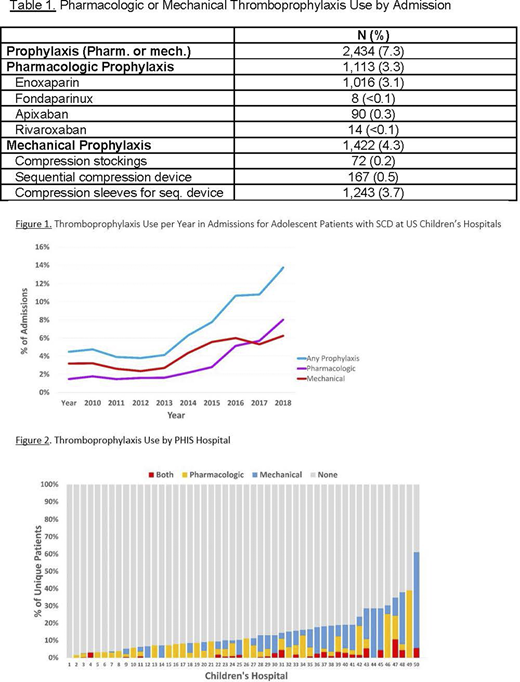Background: Evolving pediatric data, including case reports, case series, and combined adult and adolescent cohort studies, suggest an increased prevalence of venous thromboembolism (VTE) in children with Sickle Cell Disease (SCD) who undergo central venous catheter (CVC) placement (Ko RH and Thornburg C, Front Pediatr, 2017). Additionally, VTE has been shown to affect patients with SCD at a younger age compared to African-American controls (Stein PD, et al, Am J Med, 2006). Anecdotally, pediatric hematologists acknowledge the VTE risk in pediatric patients with SCD and have been using thromboprophylaxis in their patients despite the lack of standardized guidelines. The goal of this retrospective cohort study is to assess the utilization of pharmacologic and non-pharmacologic thromboprophylaxis in adolescent patients with SCD using a large pediatric database.
Methods: The data source for this multicenter cohort study was the Pediatric Health Information Systems (PHIS), an administrative database that contains clinical and resource utilization data for inpatient, ambulatory surgery, emergency department, and observation unit patient encounters for 49 freestanding children's hospitals in the US. ICD-9-CM and ICD-10-CM codes were used to identify subjects, including SCD genotype (SS, SC and SB0 thal) and other comorbidities (acute chest syndrome, vaso-occlusive crisis, osteomyelitis, and bacteremia). We included subjects, aged 13-21 years, admitted to any PHIS hospital between 01/01/2010 - 12/31/2019. Subjects with a history of VTE were excluded. Supply billing codes were used to identify CVC placement and mechanical prophylaxis. Pharmaceutical billing codes were used to identify anticoagulant use.
Results: 6,903 unique patients (3,147 male) met inclusion criteria with a median age of 17.2 years (13.0-21.9 years). These patients comprised a total of 33,298 admissions, with 2,434 (7.3%) admissions identified as receiving pharmacologic or mechanical prophylaxis (Table 1). 4.3% of the total admissions received mechanical prophylaxis and 3.3% received pharmacologic prophylaxis. Enoxaparin was the most commonly used anticoagulant, utilized in 91.3% of admissions in which pharmacologic anticoagulation was prescribed. The use of thromboprophylaxis was noted to increase over the study period, with significant increases observed in both pharmacologic and mechanical prophylaxis(p<.0001; Figure 1). The percentage of unique patients receiving thromboprophylaxis at each participating institution is shown in Figure 2.
WConclusions: Use of both pharmacologic and mechanical thromboprophylaxis in hospitalized adolescent patients with SCD has increased in the last decade. However, there is variability amongst pediatric hospitals regarding the use and preferred method of thromboprophylaxis. Prospective cohort studies are needed to determine VTE risk factors in adolescents and children with SCD and the efficacy of prophylaxis regimens. These studies will help guide the development of VTE prophylaxis regimens.
Davila:ATHN: Other: Grant Funding; Spire Learning: Speakers Bureau. O'Brien:Bristol Myers Squibb: Consultancy, Membership on an entity's Board of Directors or advisory committees.
The use of Direct Oral Anticoagulants and Enoxaparin in children
Author notes
Asterisk with author names denotes non-ASH members.


This feature is available to Subscribers Only
Sign In or Create an Account Close Modal